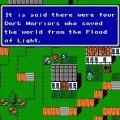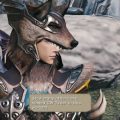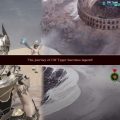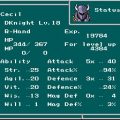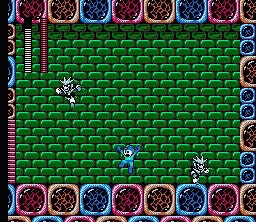Final Fantasy Retrospective: Final Fantasy IV

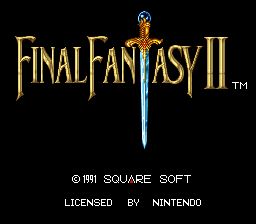
Welcome to 2021. Somehow we’ve survived another year, one that literally tried to kill us all, and as a reward, we have a pair of shiny new video game consoles to ogle over. With each new generation of gaming console comes the ability to innovate, with increased processor power and storage space available to developers. Where they might once have had to cut a corner and limit their vision, now they can watch their vision become a reality and stretch the limits of what they can do. Or just pour more money into graphics because apparently that’s all that matters these days.
It’s also super hard to find one of these shiny new consoles right now, so let’s look back at the start of the SNES generation, when developers were able to stretch the limits of what they could do compared to what they were capable of on the NES. Although Dragon Quest was the first to market on the NES, acting as the origin point of the JRPG genre, Final Fantasy would beat them to the next generation by about a year, although Enix was certainly not slacking. Their ActRaiser predated Final Fantasy IV by several months.
The two series still seemed to be pushing each other forward, too. Dragon Quest IV was the first in the series to use the full Overture that we’ve come to know and love and, not to be outdone, Nobuo Uematsu augmented the Prelude with a new harmony line to go with his melody for Final Fantasy IV. He’d already tried to marry harmony and melody in Final Fantasy III with compositions like the overworld theme of the game, “Eternal Wind”, but the NES wasn’t capable of truly playing the song in the way that it was meant to sound, especially since sound effects would typically cause some notes to be skipped. Not only was the SNES capable of playing sound effects at the same time as the music, harmony and melody could play together like they were always meant to.
The SNES was also where the developers at Square began to experiment with the presentation of their games. Previous Final Fantasy games opened with white text on a blue background. Final Fantasy IV, however, opens on an airship squadron flying across an ocean.
Affirmation
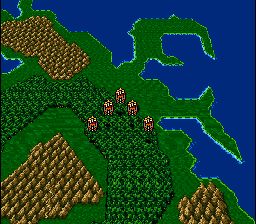 In what is now considered an iconic scene in gaming history, Final Fantasy IV introduces us to its world while flying thousands of feet above the ground. Dark Knight Cecil and his Red Wings are on their way home from having forced the Mysidians to give up their crystal. Monsters are also increasing in the world, a troubling phenomenon indeed.
In what is now considered an iconic scene in gaming history, Final Fantasy IV introduces us to its world while flying thousands of feet above the ground. Dark Knight Cecil and his Red Wings are on their way home from having forced the Mysidians to give up their crystal. Monsters are also increasing in the world, a troubling phenomenon indeed.
The prologue of the game is relatively long when compared to the series’ debut on the NES, where the first game throws you on the world map right away, the second game offers a couple minutes of introduction before throwing you on the world map and the third game immediately throws you into the first dungeon. The game also begins its action in medias res. Although it’s not as blatant as later games in the series, we still skip over Cecil waking up one day and being told by the king to go grab the crystal. He’s already on his way back from his successful mission when we first see him.
It’s a good thing we start at this point rather than way back when Cecil first gets the order to steal the crystal, or even when he’s first taken in by the king of Baron Castle. With how quickly the game is paced, a slow opening might’ve turned off many players at the start who want their games to move like a locomotive, and might’ve turned off the rest of the players when the action started speeding up because they were expecting a Dragon Quest style slow burn. While it might’ve been interesting to meet the king back when he first took Cecil in and presumably back when the king wasn’t evil, it’s for the best that we don’t get stuck with a lengthy prologue. The overall replayability of the game might’ve suffered.
The intro of the game does well to introduce many of the main players in the drama. Cecil is a Dark Knight who is beginning to question both his king and himself, wondering if his actions are slowly eroding any of the goodness in his heart or even the free will of his soul. Kain is a Dragoon and Cecil’s best friend, and seemingly his only true friend on the battlefield. The two are like brothers and have each other’s backs at all times. Rosa is Cecil’s girlfriend and she tries to support him as best she can, but not even her White Magic can heal the scars Cecil carries beneath the surface. Cid is the mechanical genius of Baron Castle and like Rosa, tries his best to support Cecil, but even he is at a loss to figure out how to help the Dark Knight.
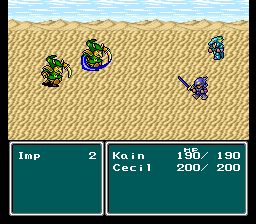 One of the biggest criticisms of Final Fantasy IV I’ve seen is that you can just press X (or A, depending on which console you’re playing it on) to win and this is especially true outside Baron and in the first dungeon. Enemies are so slow that you can pretty much hold the attack button and everything just dies.
One of the biggest criticisms of Final Fantasy IV I’ve seen is that you can just press X (or A, depending on which console you’re playing it on) to win and this is especially true outside Baron and in the first dungeon. Enemies are so slow that you can pretty much hold the attack button and everything just dies.
If you’ve played anything other than the Easytype version released in North America on the SNES, then you know that Final Fantasy IV is definitely not the easiest game in the series, but those first couple areas are. On the NES, in both Final Fantasy and Dragon Quest, enemies in the starting areas are strong enough that you need to continually stay in hotels if you want to grind until you’re strong enough that their attacks don’t do more than tickle.
The reason these starting areas are easy is simply because Final Fantasy IV introduces players to the brand new Active Time Battle system. Instead of being strictly turn-based, where you choose your actions and watch them happen, your actions occur in real time. It’s like the difference between playing Uno against a friend and running a marathon against a friend. Given that it’s the first time we’re expected to fight in real time, the game eases us into it by giving us the slowest possible enemies to fight against while providing characters that are already level ten, with three digit HP. Once the game is satisfied that we’re used to this brand new battle system, we meet the first boss and it becomes our first real test (although if you gain a few levels, you can pretty much destroy the boss before any of the actual mechanics happen). The boss’s mechanics punish you for attacking during specific phases, so we’re immediately introduced to more complex mechanics than what we had to deal with on the NES.
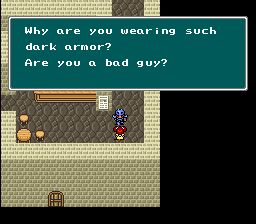 We also deal with more complicated characters. Final Fantasy IV is probably the first RPG to feature a character who suffers from a form of depression. Cecil feels like he’s nothing more than a tool for killing and it really hurts him. He sinks deeper into his depression as he continues on his journey away from Baron and loses his best friend, and it all comes to a head when he shipwrecks and finds himself washed up on the shores of Mysidia. There, he endures the ridicule and hostility of the surviving mages, who even go so far as cast negative status effects on him in revenge for his attack in the prologue. However, the elder of Mysidia shows pity on him and tells him of a way to cleanse his soul. If he were to go to Mount Ordeals and pass the trial there, he’ll become a Paladin and thus he’ll be rid of the darkness that clings to him and he’ll turn into a radiant being of light.
We also deal with more complicated characters. Final Fantasy IV is probably the first RPG to feature a character who suffers from a form of depression. Cecil feels like he’s nothing more than a tool for killing and it really hurts him. He sinks deeper into his depression as he continues on his journey away from Baron and loses his best friend, and it all comes to a head when he shipwrecks and finds himself washed up on the shores of Mysidia. There, he endures the ridicule and hostility of the surviving mages, who even go so far as cast negative status effects on him in revenge for his attack in the prologue. However, the elder of Mysidia shows pity on him and tells him of a way to cleanse his soul. If he were to go to Mount Ordeals and pass the trial there, he’ll become a Paladin and thus he’ll be rid of the darkness that clings to him and he’ll turn into a radiant being of light.
This could be meant as a reference to the ability to change your class in Final Fantasy III. Because you required a resource known as Capacity to change class in that game, it’s assumed that such a process has to have required a little bit of effort. Cecil going on a quest to a mountain of ordeals sounds about right.
Cecil’s transformation resolves his depression and he’s suddenly a lot more comfortable in his body. Yes, I am deliberately alluding to the transgender community because although Cecil stays male throughout the game, there are parallels here that can’t be ignored. Cecil’s quest to become the Paladin that he is deep down might not have been intended as a transgender fable, but it definitely reads as one.
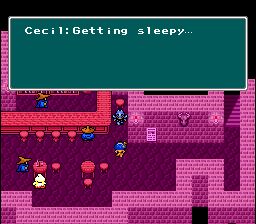 The one flaw with Mysidia, in my opinion, is that there is a witch who offers to dance for him in the bar and if he accepts – since there are dancers all over the world in this game who perform a dance for you if you talk to them – she’ll put a sleep spell on Cecil and when he awakens, he’s in a much more porcine shape. This is the only Final Fantasy game which features a pig transformation as a status effect. That said, I don’t recall any enemies that survive long enough to cast it on the party, and it seems like it only really applies to the Mysidia section of the game. Characters with access to Black Magic can cast the status effect on enemies if they want to, and it disables the enemy if successful. Magic users find themselves unable to cast spells and can only attack physically. I assume the enemy can only oink and squeal and it disrupts their ability to use magic. It’s not as bad as Toad, which reduces your physical abilities as well, so if a purely physical fighter gets piggied, it might not have much of an effect at all.
The one flaw with Mysidia, in my opinion, is that there is a witch who offers to dance for him in the bar and if he accepts – since there are dancers all over the world in this game who perform a dance for you if you talk to them – she’ll put a sleep spell on Cecil and when he awakens, he’s in a much more porcine shape. This is the only Final Fantasy game which features a pig transformation as a status effect. That said, I don’t recall any enemies that survive long enough to cast it on the party, and it seems like it only really applies to the Mysidia section of the game. Characters with access to Black Magic can cast the status effect on enemies if they want to, and it disables the enemy if successful. Magic users find themselves unable to cast spells and can only attack physically. I assume the enemy can only oink and squeal and it disrupts their ability to use magic. It’s not as bad as Toad, which reduces your physical abilities as well, so if a purely physical fighter gets piggied, it might not have much of an effect at all.
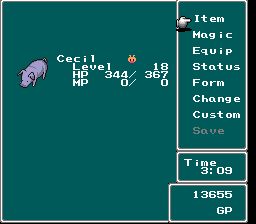 Anyway, the flaw becomes apparent after Cecil becomes a Paladin, since this witch still offers to dance for Cecil, still puts Cecil to sleep and when he awakens, he’s oinkified again. In fact, if you come back later with a full party, the witch still offers to dance for the party, still puts the party to sleep, and now the entire group are pigs. It seems she can never forgive Cecil and doesn’t care if innocent people are sent to the pig sty, she considers them guilty by association.
Anyway, the flaw becomes apparent after Cecil becomes a Paladin, since this witch still offers to dance for Cecil, still puts Cecil to sleep and when he awakens, he’s oinkified again. In fact, if you come back later with a full party, the witch still offers to dance for the party, still puts the party to sleep, and now the entire group are pigs. It seems she can never forgive Cecil and doesn’t care if innocent people are sent to the pig sty, she considers them guilty by association.
If Cecil is a pig and talks to her again, she still offers to dance for him, still puts him to sleep and still casts Piggy on him, which turns him back to normal since that’s how the transformation spells work in Final Fantasy. It almost feels like a programming oversight, or possibly a means of being a little merciful on the player since they might not have the right item to reverse the spell.
Upon becoming a Paladin, Cecil is granted access to the Serpent Road, a kind of underground passage between Mysidia and Baron. The Road had been sealed following Baron’s attack, but as far as I can tell, no one actually attacked Mysidia using the Road. The attack came from the sky. I presume the Road was sealed as a preventative measure, but it’s been suggested that traveling the Road brings great peril, for to use it, your strength is sapped, so to attack Mysidia from the Road would be rather stupid since you’d be weakened and the mages would likely make short work of you. It sounds a lot like one of the gimmick dungeons from Final Fantasy III, but once the Serpent Road is unlocked, Cecil steps into a teleport, the game’s camera pans from Mysidia to Baron, and Cecil steps off the teleport on the other side as if Scotty beamed him up. It’s a weird sort of let down that the Serpent Road isn’t actually a dungeon.
The old waterway beneath Baron is where we’re expected to practice figuring out elemental weaknesses. Although veterans can likely remember (or logically figure out after a quick trial and error) what the ideal element to use against each enemy is, newcomers can Scan enemies in the waterway and find out what their weaknesses are, then cast the appropriate spells and equip the appropriate talons onto Yang. Prior to that, players can buy two each of Yang’s fire, ice and lightning claws and although they don’t add any extra points to his attack or strength stats, they add elemental damage. This damage does nothing for enemies that are neutral to the element in question, but deals a decent bonus to his attack against enemies weak to specific elements. If an enemy is weak against lightning, it’s pretty obvious that Yang would want to equip the claws that would deal lightning damage.
The dungeon is just long enough that the twins Palom and Porom should only just run out of MP by the time they reach the save point at the end, but if they’re running out early, a bit of grinding might be necessary at this point to make them stronger.
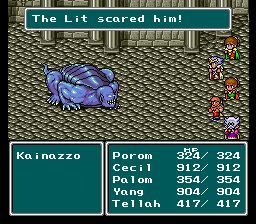 Upon leaving the dungeon, a pair of interesting boss fights occur, one where players learn how to use a mirror spell, Reflect (originally translated as Wall), which reflects magic onto an enemy. The ideal solution then becomes having Tellah, who just got back all his spells, to cast Wall on an ally and then said ally gets bombarded with black magic spells that redirect onto the enemy until Wall wears off. The other fight involves using lightning spells to disrupt a water-elemental boss’s mechanics and prevent massive damage from occurring. Ideally, players will have learned that water’s main weakness is lightning from fighting so many water-elemental enemies in the old waterway, but even if that isn’t the case, it may still be possible to work it out on the fly, but his waves of water are powerful and can cause a game over or two before new players get the hang of it.
Upon leaving the dungeon, a pair of interesting boss fights occur, one where players learn how to use a mirror spell, Reflect (originally translated as Wall), which reflects magic onto an enemy. The ideal solution then becomes having Tellah, who just got back all his spells, to cast Wall on an ally and then said ally gets bombarded with black magic spells that redirect onto the enemy until Wall wears off. The other fight involves using lightning spells to disrupt a water-elemental boss’s mechanics and prevent massive damage from occurring. Ideally, players will have learned that water’s main weakness is lightning from fighting so many water-elemental enemies in the old waterway, but even if that isn’t the case, it may still be possible to work it out on the fly, but his waves of water are powerful and can cause a game over or two before new players get the hang of it.
The setting of a trap meant to crush the party is the reason for the sacrifice of Palom and Porom, and as sad as the scene is, it’s another entry in a soon to be long running series of mini essays on the nature of status effects in the Final Fantasy universe. I’ve already covered the peculiar nature of the Toad spell in Final Fantasy II in relation to the rest of the series, and how a fully amphibious party is considered permanently defeated despite that they should theoretically be able to use items on one another. Now obviously, if a party is completely turned to stone, the game is over because no one’s around to turn them back. However, if one or two people are turned to stone, they can be softened up with a gold needle after the fight’s over. At least, that was the assumption, until Final Fantasy IV.
In order to stop the walls from closing in around them, Palom and Porom transform themselves into stone statues, making cute bookends of themselves and somehow being heavy enough to halt the mechanism drawing the walls together. Tellah’s attempt to Esuna them back to life fails, however. It’s stated by the game that since they petrified themselves of their own free will, they can’t be turned back. It’s possible they they used their Twin power to augment the spell, adding hidden stipulations that prevent normal spells from turning them back, but perhaps there’s something else at work here.
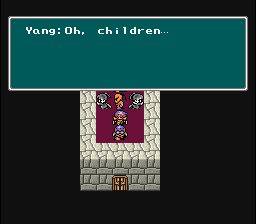 If someone else were to cast a petrification spell on themselves, or Toad or Piggy or whichever status effect they wanted to try, it’d be fairly easy to just use an item to turn them back. But then, I suppose there’d also be a question of intent. Turning yourself into a pig for the sake of an experiment would seem to bring with it the expectation that it’s not a permanent change of shape and you’re likely wanting to be able to turn yourself back right away, and having the spell cast upon you by the dancer in Mysidia is also obviously not a desirable effect and perhaps your wish to return to human form is what makes the Esuna work. Or the Diet Food, if you have some. It’s also assumed that most statues transformed by the petrification spell don’t want to be a statue in the first place and therefore can be changed back.
If someone else were to cast a petrification spell on themselves, or Toad or Piggy or whichever status effect they wanted to try, it’d be fairly easy to just use an item to turn them back. But then, I suppose there’d also be a question of intent. Turning yourself into a pig for the sake of an experiment would seem to bring with it the expectation that it’s not a permanent change of shape and you’re likely wanting to be able to turn yourself back right away, and having the spell cast upon you by the dancer in Mysidia is also obviously not a desirable effect and perhaps your wish to return to human form is what makes the Esuna work. Or the Diet Food, if you have some. It’s also assumed that most statues transformed by the petrification spell don’t want to be a statue in the first place and therefore can be changed back.
But what if you resign yourself to such a fate and willingly wish to be a statue forever? For Palom and Porom, they probably thought that the world was more important than a pair of kids and they trusted that Cecil could do the job without them, especially with the “great sage” Tellah along to help (wow, did they drastically overestimate Tellah). So when they petrified themselves in order to halt the walls’ progress, they might have truly believed that they wanted to be a pair of statues forever. That wish, that desire of themselves to never be human again is likely what prevents Tellah from turning them back.
As a side note, this insight into the mechanics of Palom and Porom’s transformation may also help explain why a party of four toads was considered a game over in Final Fantasy II. It was the first time the spell was ever used in Final Fantasy, and no one told the characters what the mechanics were, so perhaps they assumed that if they were all toads, they had no choice but to abandon their quest and live the rest of their lives catching flies and croaking in the sunset. The momentary panic of losing their humanity may have locked their transformations in place and no amount of Maiden’s Kiss potions would turn them back.
So when the player was forced to turn everyone into toads to get through specific puzzles in Final Fantasy III, it helped teach both the player and the characters what the mechanics of the toad spell were supposed to be. Once they saw that they could turn back after crawling through the first arbitrarily placed toad hole, the status effect had no real power over them, or over any other hero to come afterwards.
Of course, it turns out the Elder of Mysidia knows how to subvert the will of Palom and Porom and turn them back to flesh and blood, but I’m getting way ahead of myself here.
Crash and Burn
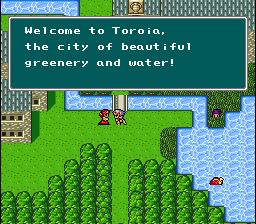 To get a sense of how quickly the game is paced, all of the above takes place within the first five hours. By the time the game hands control back to you after stoning Palom and Porom, allowing Golbez to notice that the second of the Four Fiends is defeated, and having Kain offer to ransom Rosa back to you in exchange for the crystal in Troia, the clock will typically read a few minutes past the five hour mark, unless players are a bit slower in their progression and are trying to gain a bit of extra power as they go.
To get a sense of how quickly the game is paced, all of the above takes place within the first five hours. By the time the game hands control back to you after stoning Palom and Porom, allowing Golbez to notice that the second of the Four Fiends is defeated, and having Kain offer to ransom Rosa back to you in exchange for the crystal in Troia, the clock will typically read a few minutes past the five hour mark, unless players are a bit slower in their progression and are trying to gain a bit of extra power as they go.
It is the Troia sequence that really drives home how frustrating Tellah is when he’s your party’s only battle mage. He’s a Sage, so he can cast both White and Black Magic, but for some reason, he only has 90 MP. He’s supposed to be this legendary magic user, but Palom and Porom overtake him in the MP department long before they permanently remove themselves from your party. After that, Cecil the Paladin (a tank character who can use limited White Magic) overtakes Tellah in the MP department around level 22. All the while, as Tellah levels up, his physical stats go down, so he becomes more and more reliant on his magic in his old age of level 26. Rydia is going to be capable of much higher damage with her Black Magic when she returns to the party and by the time Rosa stops being transformed into a damsel in distress and starts being a party member again, her healing power is going to be far superior to Tellah. The only reason to have Tellah along is because he can do both… except that, although he can cast every spell once he remembers how again, his power is a lot lower than you’d expect from a Sage. His HP is also abysmal, so he’s stuck in the back row, which doesn’t save him from retaliation when you physically attack the Hell Needle on your way north to hitch a ride on the Black Chocobo to the magnetic cave you’re supposed to explore next. So it seems like the appropriate thing to do is to attack with magic, and you might as well use a strong enough spell to take care of them. So you cast something like Firaga, since Fira on all five targets (or four or three by the time he finishes his casting time) doesn’t do enough damage to kill everything unless you grind a little, and that means that Tellah runs out of magic after three battles since he only ever has 90 MP. He’ll always have 90 MP no matter what, unless you know about the glitches speed runners use so that they can actually cast Meteor whenever they want, but for the rest of us, you can level Tellah up as much as you want, he’s never going to have more than 90 MP, which means you might as well make Cecil your healer and heal up after battles and then after three battle-ending Firaga spells, head into the chocobo forest and catch the white chocobo to restore everyone’s MP or if you get into a fourth battle, use Osmose on one of the enemies so he has enough MP to last one more battle and cast Firaga in that one before catching the white chocobo and…
Yeah, this is not a good time in the game to try to grind if you think you might not have enough levels to deal with the upcoming challenges. Tellah’s never increasing mana pool can be drained fairly quickly unless you decide to just physically attack everything and take all the counterattacks, but then he’s stuck healing everyone anyway and it’s not really much of a savings of MP. In fact, if you are dealt enough damage, you might as well have just cast Firaga in every battle since the MP expense would be the same.
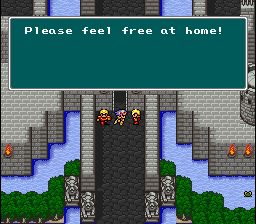
This is the downside to Final Fantasy IV‘s revolving door of characters which Final Fantasy II‘s revolving door of characters never really touched upon. In Final Fantasy II, the three main characters can be molded however you want, so you always have your core three which can defeat any challenge and sometimes you have a fourth character who can come along and ease some of the burden on the party, depending on how you set them up, who your spell caster is and which spells are going to be useful in the next dungeon. In Final Fantasy IV, you’re constantly having to adjust to new party dynamics. It’s great when you have Rydia in your group early on because she can heal and deal damage and if you summon Chocobo during a boss fight, that’s a decent chunk of damage being done right there. It’s great when Rosa accompanies you after you cure her of Sand Fever since she’s pretty decent at healing even if her accuracy with a bow is somewhat lacking at that point (in fact, it is this low accuracy on White Mage characters and healers in general that would plague the series all the way up to and including the current MMO, Final Fantasy XIV), so unfortunately she’s somewhat useless unless you need some healing done, which at that point in the game, you really don’t. It’s great having Palom and Porom in your party because now you have more magic you can cast, plus they start at a relatively low level so they’re improving practically every other battle and soon their power level will rival and somewhat surpass Tellah’s. When Cecil becomes a Paladin… well, let’s just say the walk back home is rather painful, since the ultimate dark sword he got from the elder at Mysidia is gone and transformed into a sword of light. He has lost the instant death ability that made killing Zu so efficient and now it takes a few hits to kill one. He has also lost his Dark ability which just requires a little bit of White Magic from his party to counteract its HP depleting effect (Dark was dummied out of the Easytype version on the SNES). The weapon that his dark sword becomes is rather laughably weak and after a few hours as a Dark Knight with weapon upgrades of ever increasing strength, it kind of sucks to be wielding a starter weapon again. He does level up relatively quickly, since it’s possible to gain something like eight levels in your first battle if you’re lucky but you can easily make it to around level 15 or so by the time you’re back in Mysidia if you’re not trying to grind and even then, you’re still using the beginner weapon and Cecil’s not getting very much stronger at this point in the game.
Getting back to Tellah, he’s never really all that strong, to be honest. Sages in Final Fantasy III were capable of withstanding most enemies’ physical hits, but Tellah is about as sturdy as a wilted poinsettia that’s not been watered for a week, and physical stats fall off of him like they were the wilted poinsettia’s leaves. A stiff breeze can topple him. Early on, when he helps Cecil and Kain, he does have more HP than them and his magical abilities do help, and he also has more MP than Rydia at the start, but as was said earlier, Rydia eventually becomes better than him at around the time she leaves the party and Palom and Porom are better than him when they leave the party, too. Rosa’s out of the party for most of Tellah’s time in the party so he doesn’t really see how superior she is to him, and he only recovers most of his spells during the same Mount Ordeals sequence where Cecil becomes a Paladin. Up until then, Tellah has only tier 1 spells like Fire and Blizzard and the tier 2 healing spell Cura. His 90 MP isn’t as impactful at that point, but at first he’s a Sage who can only cast basic spells and might recall one if you’re feeling lucky, then he becomes a sage who can cast everything but doesn’t have a lot of mana to cast it from.
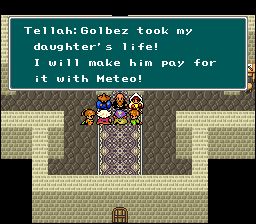 Are we sure he’s a Sage and not, say, a Red Mage? From the start, Red Mages have been considered the jack of all and master of nothing. In the first and third games, the Red Mage has been able to cast some white and some black magic but not enough of either to really excel at later levels, having to rely on physical prowess that doesn’t really match dedicated sword and board classes. Tellah doesn’t even have that, needing to use not only relatively weak weapons, but by the time he leaves the party permanently, his strength stat is as low as it’s possible to go. The explanation is that he’s suffering from the effects of old age, but his old age is somehow level 20-25 in a game where the final party will be anywhere from level 50-80 depending on how much grinding will occur. Somehow, Tellah the Sage is worse than any Red Mage that has ever graced the series.
Are we sure he’s a Sage and not, say, a Red Mage? From the start, Red Mages have been considered the jack of all and master of nothing. In the first and third games, the Red Mage has been able to cast some white and some black magic but not enough of either to really excel at later levels, having to rely on physical prowess that doesn’t really match dedicated sword and board classes. Tellah doesn’t even have that, needing to use not only relatively weak weapons, but by the time he leaves the party permanently, his strength stat is as low as it’s possible to go. The explanation is that he’s suffering from the effects of old age, but his old age is somehow level 20-25 in a game where the final party will be anywhere from level 50-80 depending on how much grinding will occur. Somehow, Tellah the Sage is worse than any Red Mage that has ever graced the series.
The Troia sequence is likely balanced around Tellah using Osmose, since several enemies have MP he can steal, and this saves money the party would otherwise be spending on Ether to keep him topped up. It’s also possible that Tellah has gotten to the point where he’s so old that the rest of the party has to support him and play nursemaid in order to keep him going. Why he’s still in the twenties, level-wise, is inexcusable at this point, other than the fact that he’s at a low enough level to still actually level up often enough that players can watch his stats atrophy. Basically, think of how much fun it is to actually take care of an elderly person who is starting to lose their fine motor skills and beginning to slur their words and forget things, and that’s Tellah. Tellah has a will strong enough to see his quest through to the end, but he is otherwise so frail that he’s going to need constant care to keep him upright.
Thinking of Tellah and his ever decreasing Strength stat brings to mind the games’ stats in general. They help tell the story, from Cecil’s ever lowering Spirit stat as he gains levels in Dark Knight and loses faith in his own goodness to Tellah literally dying before our very eyes, the stats are an interesting part of the game. One thing I’ve discovered by carefully studying them as I played was that the characters who were mind controlled in the game were either amnesiac or had much higher Spirit stats than Cecil. In fact, a theory I’ve come up with is that the king insisted on Cecil becoming a Dark Knight because his low Spirit stat would actually shield him from mind control. The king must’ve already known about Golbez and the coming near apocalypse and he needed to make sure Cecil would be capable of saving the world. Unfortunately, by the time the sequel came along, it was Cecil who became mind controlled, despite being a Paladin. It was this plot point in The After Years that began to turn the wheels in my head and helped me to come up with the theory that mind control generally requires a mind susceptible to control. Cecil was too self-aware as a Dark Knight to be controlled, which somehow is a trait of those with low Spirit. But after becoming a Paladin and I guess losing that self-awareness along with having a high Spirit stat, he becomes amazingly susceptible to it so that he can be easily controlled in the sequel. Maybe he’s easy to control because he thinks himself above mind control after casting the darkness aside.
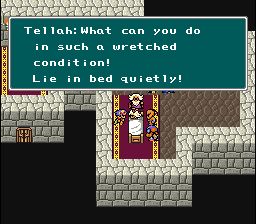 The true purpose of Tellah being restricted to 90 MP is because Meteor costs 99 and he’s supposed to become so angry when he confronts Golbez that he manages to cast the spell from his own dwindling life force and die, but again I get ahead of myself.
The true purpose of Tellah being restricted to 90 MP is because Meteor costs 99 and he’s supposed to become so angry when he confronts Golbez that he manages to cast the spell from his own dwindling life force and die, but again I get ahead of myself.
The Troia sequence also showcases why it’s important to explore every town and talk to every NPC. If you don’t, then on top of the gimmicky dungeon that must be dealt with, the dungeon’s boss will always do 9999 points of damage with each hit. Instead, you have to find and talk to your comrade Edward, who gives you a key item that will help you with the boss. The game doesn’t prevent you from heading into the dungeon, it instead will gladly punish you if you haven’t followed the game’s intended story to the letter. Later games would come up with ways to make sure you have what you need before going into the next dungeon, but in Final Fantasy IV, you’re meant to look around until you find Edward being cared for and if you don’t, you eventually lose a bunch of progress since the boss is literally impossible. By this point, it is clear that this is a game that teaches lessons as you go.
Tears of Pearls
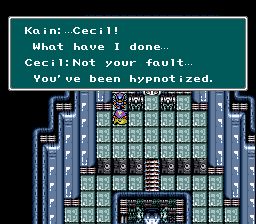 The story of Cecil and Kain is frustrating to watch play out. Kain constantly betrays the party and it makes it hard to trust the Dragoon. You never know when he’s going to turn on you again or if he’s truly okay. Suddenly joining the enemy side one too many times would destroy anyone’s trust in a person.
The story of Cecil and Kain is frustrating to watch play out. Kain constantly betrays the party and it makes it hard to trust the Dragoon. You never know when he’s going to turn on you again or if he’s truly okay. Suddenly joining the enemy side one too many times would destroy anyone’s trust in a person.
Kain’s first betrayal comes during a time when Cecil is still worrying about his own strength of character. He had been helping new ally Yang defend his home and crystal, only for Kain to show up with Golbez and steal not only the crystal but kidnap Rosa as well. Cecil is still a Dark Knight at this point and is absolutely convinced that he’s on the road to hell. Then he sees his own worst fear manifest itself in Kain, for Kain has seemingly turned fully evil and is helping the world on its course to destruction. The very next thing that happens to Cecil is that he finds himself shipwrecked and washed ashore in Mysidia where he’s at rock bottom being mocked and shouted at by the victims of his own evil deeds. And he just takes it. He’s depressed because he sees Kain acting just like he thinks he’s going to be acting towards everyone soon.
It’s possible Cecil thinks that things are getting better for him and his friends when they succeed at retrieving a crystal in the underworld at approximately the fifteen hour mark of the game (assuming some time is spent on the optional areas, I’ll get into that in a bit), but then suddenly Golbez’s voice is heard again, calling Kain back to the dark side. The end result is that Kain becomes Golbez’s puppet once more and takes the last of the underworld’s crystals without actually having to fight for it.
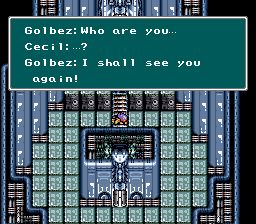 If there’s one thing that I’ve become more sensitive to in recent years when playing a game, it’s villains confronting the heroes and leaving them alive for seemingly no reason. “You’re not worth the effort to kill,” is typically the gist of the conversation, if there even is one at all. This begs the question, if the heroes are so weak that you feel the need to comment on it as you leave them lying there, broken and humiliated, why shouldn’t you kill them off? They certainly have been trying to kill you, and you’re probably more likely to make them even more determined to figure out your weakness and gain enough strength to defeat you, rather than make them too discouraged to continue the fight. In the case of Kingdom Hearts III, they already killed you, so you should at least try to get rid of them in revenge, Maleficent.
If there’s one thing that I’ve become more sensitive to in recent years when playing a game, it’s villains confronting the heroes and leaving them alive for seemingly no reason. “You’re not worth the effort to kill,” is typically the gist of the conversation, if there even is one at all. This begs the question, if the heroes are so weak that you feel the need to comment on it as you leave them lying there, broken and humiliated, why shouldn’t you kill them off? They certainly have been trying to kill you, and you’re probably more likely to make them even more determined to figure out your weakness and gain enough strength to defeat you, rather than make them too discouraged to continue the fight. In the case of Kingdom Hearts III, they already killed you, so you should at least try to get rid of them in revenge, Maleficent.
When venturing into the Tower of Zot to rescue Rosa, Cecil has a confrontation with Golbez, the confrontation where Tellah sacrifices his life to cast the legendary spell Meteor. Meteor does significantly wound Golbez, so it’s possible that in his weakened state, he senses something about Cecil and it’s that something that causes Cecil to be spared.
If you play to the end of the game, you know what the real reason Golbez would keep Cecil alive is. Granted, Golbez does try to kill Cecil and the rest of the party in the Underworld and although he’s not successful, he still gets away with another crystal. Anyway, it turns out that the two are brothers, and when Meteor broke Golbez’s control over Kain and allowed the Dragoon to return to the side of good, it’s possible it partially broke the control that Zemus had over Golbez. This would help to explain why Golbez, despite having the power to completely annihilate Cecil, would choose not to at that time.
You’re not actually supposed to know about Zemus until late in the game, and the fact that they’re brothers is literally the very last plot point the game reveals before it’s time to traverse the final dungeon, so at this point in the game, you’re left to wonder what Golbez could’ve seen in Cecil.
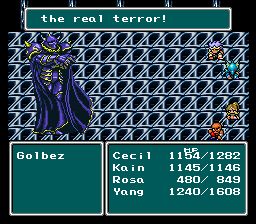 During Golbez’s second, more serious attempt to destroy Cecil, Rydia returns to the party and it’s amazing. Golbez has instant killed everyone else and just when he’s about to do the same to Cecil, Rydia arrives. She summons the Mist Dragon to remove Golbez’s Shadow Dragon from the fight, Esunas Cecil (or I guess Remedies him instead since she can’t use White Magic any more) and then he hears her voice. “You can move now.” I can imagine Cecil’s joy when he realizes she’s alive and didn’t actually drown at sea like he thought had happened to her.
During Golbez’s second, more serious attempt to destroy Cecil, Rydia returns to the party and it’s amazing. Golbez has instant killed everyone else and just when he’s about to do the same to Cecil, Rydia arrives. She summons the Mist Dragon to remove Golbez’s Shadow Dragon from the fight, Esunas Cecil (or I guess Remedies him instead since she can’t use White Magic any more) and then he hears her voice. “You can move now.” I can imagine Cecil’s joy when he realizes she’s alive and didn’t actually drown at sea like he thought had happened to her.
That said, I love how the party just stands there after the fight’s over as Golbez turns into a member of the Addams Family and grabs the crystal that they just fought to save. If he was going to do that anyway, what did the fight even accomplish, other than add a character back onto your team?
It’s arguably worse to play Final Fantasy IV knowing that characters are going to leave your party and approximately when it happens since it means withholding gear that you might otherwise have used, depending on whether you don’t think you’re going to remember to strip the character down right before the event and/or boss fight where they’re going to leave. Going into a boss fight with one or more characters severely underpowered as a result is silly, but at the same time, you feel silly for having put a really amazing piece of equipment onto Kain right before he gets mind controlled for the second time. Final Fantasy IV‘s method of story-telling, where characters come and go from the party as they please and take your gear with them (only to come back later without it… I’m looking at you, Rosa, in your “Prisoner’s Garb” when you got rescued rather than the gear I’d equipped you with) was thankfully not used again, mainly because after Final Fantasy IV, those types of characters are considered guests and can’t have their equipment messed around with. Final Fantasy also stopped creating so many characters to play as. After Final Fantasy VI topped the player off at 16 characters to choose from, the cast of characters in any given game has never reached the double digits, outside of tactical games where a higher character count is required, and also outside of certain other spin-off games like Final Fantasy Type-0. There have even been games starring one single character with no party to back them up, like Lightning Returns: Final Fantasy XIII.
Still, it’s interesting that the Super Nintendo generation was where Final Fantasy exploded in terms of character count, with two of the four games to appear on the console featuring a multitude of characters to get used to, with their own methods of helping the party.
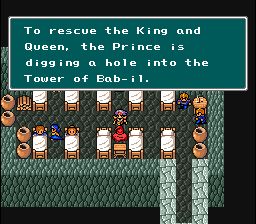 Edge enters the story past the halfway point. Rubicante is the only one of the four fiends left, most of the crystals are in Rubicante’s possession and we only hear about Eblan being decimated after climbing up the Tower of Babil. At this point, it’s likely that the player has explored around a little and maybe gained enough power that things are dying much faster than before. If the Troia sequence is where the party gets over the hump and starts to have an easier time of battle again, the Tower of Babil is where the party finds its groove and then the cave outside of Eblan gives very little trouble. When Edge joins, he’s relatively weak compared to the rest of the party, possibly even ten levels or more below the group’s average, depending on how thorough a player is in clearing out dungeons, and if anyone’s going to die first, it isn’t Rydia, it’s Edge. At this point, Edge has less than half the HP of someone like Kain or Cecil and in extreme cases, Rosa, and yet Edge is stuck in the front row unless the player plans to make liberal use of his Throw command. It’s possible that players hate Edge for this, and to be fair, he does seem like The Load. He needs a lot of work in a short period of time in order to make him feel useful, and his best damage comes from throwing shuriken and spare weapons, so having him in the group is also expensive if you want him to be any good. That said, he joins the party at a point in time when money stops being very useful, having already been to most of the shops in the game and purchased most of the best gear that money can buy. From Eblan onward, the best gear will often be found in treasure chests, so other than maybe some consumable items, the money you’re carrying around is going to go to waste. If anything, Edge joins right when the player can afford to keep him stocked up with shuriken, and just in case the player can’t, there’s a treasure chest in the top half of the Tower of Babil, accessible in the cave outside of Eblan, that contains a significant amount of gil.
Edge enters the story past the halfway point. Rubicante is the only one of the four fiends left, most of the crystals are in Rubicante’s possession and we only hear about Eblan being decimated after climbing up the Tower of Babil. At this point, it’s likely that the player has explored around a little and maybe gained enough power that things are dying much faster than before. If the Troia sequence is where the party gets over the hump and starts to have an easier time of battle again, the Tower of Babil is where the party finds its groove and then the cave outside of Eblan gives very little trouble. When Edge joins, he’s relatively weak compared to the rest of the party, possibly even ten levels or more below the group’s average, depending on how thorough a player is in clearing out dungeons, and if anyone’s going to die first, it isn’t Rydia, it’s Edge. At this point, Edge has less than half the HP of someone like Kain or Cecil and in extreme cases, Rosa, and yet Edge is stuck in the front row unless the player plans to make liberal use of his Throw command. It’s possible that players hate Edge for this, and to be fair, he does seem like The Load. He needs a lot of work in a short period of time in order to make him feel useful, and his best damage comes from throwing shuriken and spare weapons, so having him in the group is also expensive if you want him to be any good. That said, he joins the party at a point in time when money stops being very useful, having already been to most of the shops in the game and purchased most of the best gear that money can buy. From Eblan onward, the best gear will often be found in treasure chests, so other than maybe some consumable items, the money you’re carrying around is going to go to waste. If anything, Edge joins right when the player can afford to keep him stocked up with shuriken, and just in case the player can’t, there’s a treasure chest in the top half of the Tower of Babil, accessible in the cave outside of Eblan, that contains a significant amount of gil.
There’s the point when you return to the Tower of Babil and Edge finds his parents. His parents who had been experimented on by the mad scientist that we’d already defeated in the tower from before. They’re at first controlled by their new bestial nature and are trying to kill the party… with very weak spells that target a single party member. Even the Fira spells being used don’t do more than 70 or so damage, so it’s impossible for anyone to die here, not even Edge, who is the relative weakling of the group. Soon, his parents break free and return to their own minds, upon which they cease all attacks, express sorrow at their fate and willingly die. The relatively weak spells, though, made it clear that they were so inherently themselves that even when they weren’t, they tried their hardest not to kill anyone. They were holding back their power.
Final Fantasy V would take this sort of concept one step further during a notorious scene where one of the game’s characters fights beyond his physical limitations, being dropped to 0 HP by a single cast of Exdeath’s magic, but he keeps going because his love for his daughter is incredibly strong. Both games use the concept that characters will permanently die if they push themselves beyond the limits of their stat points, whereas if you just hit 0 HP and drop to the ground, you should be able to get back up again with a Phoenix Down.
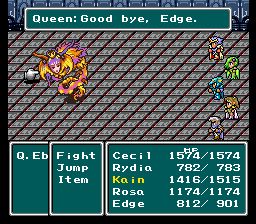 Getting back to the king and queen of Eblan, what I find most interesting is that their monstrous forms – which were admittedly not all that monstrous, the queen looked quite elegant to my eyes – didn’t matter at all to Edge. He was able to see past their looks and begged for them not to die. He likely would’ve helped them retain a sense of self and feel human again, even though they physically were not. Given that Edge is sweet on Rydia for the remainder of the game and Rydia grew up among the summons of the underworld, creatures that are usually called “summoned monsters” despite that there are better terms used at various points in the series, like “espers”, “eidolons”, “guardian forces” and even just basic “summons”, it’s good for Rydia that Edge has shown he’s capable of treating someone that looks like a monster as if he or she were human. Perhaps a relationship between them would work after all.
Getting back to the king and queen of Eblan, what I find most interesting is that their monstrous forms – which were admittedly not all that monstrous, the queen looked quite elegant to my eyes – didn’t matter at all to Edge. He was able to see past their looks and begged for them not to die. He likely would’ve helped them retain a sense of self and feel human again, even though they physically were not. Given that Edge is sweet on Rydia for the remainder of the game and Rydia grew up among the summons of the underworld, creatures that are usually called “summoned monsters” despite that there are better terms used at various points in the series, like “espers”, “eidolons”, “guardian forces” and even just basic “summons”, it’s good for Rydia that Edge has shown he’s capable of treating someone that looks like a monster as if he or she were human. Perhaps a relationship between them would work after all.
Edge also shows great initiative for a prince. In fact, several members of the cast are royalty who rise to the occasion and defend the world from a great evil. They don’t send their servants or vassals or knights. They deal with things themselves. Granted, Cecil is a Dark Knight at the beginning of the game, but he’s apparently the next in line for the crown since he’s king by the end of the game.
Break Me Shake Me
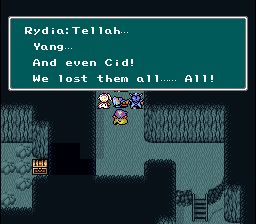 It’s hard to tell whether Final Fantasy IV‘s character sacrifices are supposed to be taken seriously, since most of them are reversed anyway as the plot demands, or if they’re the result of a little bit of self-parody by the developers in response to the dramatic turns the plot of Final Fantasy II took at times. Both games share a trend of characters volunteering to die for one another, but most of these deaths aren’t permanent in Final Fantasy IV.
It’s hard to tell whether Final Fantasy IV‘s character sacrifices are supposed to be taken seriously, since most of them are reversed anyway as the plot demands, or if they’re the result of a little bit of self-parody by the developers in response to the dramatic turns the plot of Final Fantasy II took at times. Both games share a trend of characters volunteering to die for one another, but most of these deaths aren’t permanent in Final Fantasy IV.
The first time party members are presumed dead happens after an upset Rydia summons Titan and defeats Kain and Cecil. Cecil wakes up and Kain is missing, presumed dead. He’s later seen, mind controlled and working for Golbez. When Leviathan attacks the party, everyone but Cecil is lost at sea. Edward is eventually found being cared for in Troia, Yang is temporarily mind controlled due to amnesia and is found in Baron, and Rydia is eventually found in the Underworld, having been taken in by Leviathan and raised in a land where time flows differently.
Palom and Porom turn themselves into permanent stone statues and are still revived by their Elder. Then Tellah casts Meteor and kills himself in the process, becoming the only permanently dead playable character in the entire game.
Yang blows himself up in an explosion to prevent the dwarves from dying to the Super Cannon and is later found being taken care of by Sylphs. Cid blows himself up in an explosion so that the rest of the party can escape Golbez’s allies and is later found being taken care of by dwarves.
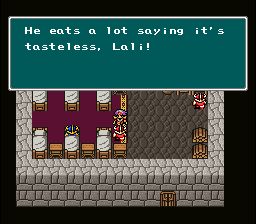
When I first played this game nearly twenty years ago, it was annoying that the game was unwilling to let any of these consequences stick. As a result, I didn’t like the game. I’ve since warmed up to it but your mileage may vary.
A lot of these characters don’t receive much development, mainly because they’re not going to be in the party for very long. Edward is given a pep talk from beyond the grave by his dead girlfriend Anna, and that apparently makes him a bit braver in the future, but he doesn’t do anything else in the story except go overboard during the Leviathan attack and then wash up ashore near Troia, where the doctors there take care of him. When there, he gives the party the next key item required by the game and then struggles out of his sick bed when the party needs a quick boost from his harp. He also shows up late in the game to offer emotional support with the rest of the temporary party members, but aside from that, his contributions to the game have ended. His overall character development ends before the in game clock hits the two and a half hour mark, and this is generally a twenty to thirty hour game.
Characters come and go all the time in the game and not all of them are developed beyond their initial state. Palom and Porom don’t receive any development at all, they are unchanging from the moment they join the group to the moment they reveal they were spying on us and all the way up to the point they turn themselves to stone. They don’t have any defining character moment where they come to the realization that the world is in serious danger and that Cecil is the only one who can unite the world and defend it from the monsters that are besieging it. They are, at most, a living plot point, meant to provide the player with the means to get through Mount Ordeals, nothing more.
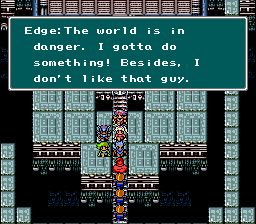 Characters who are in the party a while have more time to develop, but Edge’s development begins and ends in the dungeon he’s introduced. It’s the same dungeon where his parents’ fate is revealed and then he gets his revenge on Rubicante. After that, he basically hits on Rydia a lot and… nothing else.
Characters who are in the party a while have more time to develop, but Edge’s development begins and ends in the dungeon he’s introduced. It’s the same dungeon where his parents’ fate is revealed and then he gets his revenge on Rubicante. After that, he basically hits on Rydia a lot and… nothing else.
Even still, it is a step above the character development of prior games. The playable characters in the first three games were all largely a blank slate, other than finding out that Guy can speak to beavers. Sure, the point of the first three games was that it was you who went on those journeys and freed the world from evil. You were a band of Light Warriors in the first game, a band of resistance members who came with names attached already and who were helped by various defined characters in the second game, and a group of immature boys in the third, but in all three cases, the playable characters received no development and didn’t grow as characters other than through their stats. Not counting temporary party members in the second game, Final Fantasy IV is the first game in the series to try to develop the playable cast. As such, it’s easy to see why the game might not be as developed in that area as it is in others.
All Around Me
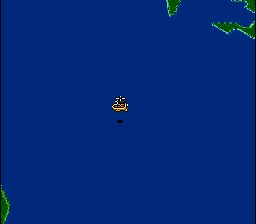 There are a few points where the game opens up to exploration. Acquiring the first airship allows you to go to places like Eblan early, although there is a treasure chest that spawns super powerful monsters and so it should be avoided at that point in time, except in the Easytype version of the game. When Cid, as his final request before he sacrifices himself (and then gets better), has you go and upgrade the airship you’ve been using on the overworld with a grappling hook so that you can carry the hovercraft with you, you can suddenly go and visit places like a cave where you can trade tails for hunks of metal, which is rather useless at that point since you don’t have access to the tails yet. (And given how much trouble it is to get most of those tails, most players won’t even bother.) Instead, this is the point where you’re supposed to go to the cave outside Eblan. Finally, there’s the upgrade of the Falcon once you’ve stolen it after defeating Rubicante. This is where the game finally, truly opens up and you can go do a bunch of side quests first or go ahead and continue the main story. These side quests also seem to be balanced in such a way that they represent a decent challenge for players to achieve, as if encouraging them to continue the main story instead if they want to play safe, and to try them anyway if they want to face tough challenges and acquire fantastic rewards.
There are a few points where the game opens up to exploration. Acquiring the first airship allows you to go to places like Eblan early, although there is a treasure chest that spawns super powerful monsters and so it should be avoided at that point in time, except in the Easytype version of the game. When Cid, as his final request before he sacrifices himself (and then gets better), has you go and upgrade the airship you’ve been using on the overworld with a grappling hook so that you can carry the hovercraft with you, you can suddenly go and visit places like a cave where you can trade tails for hunks of metal, which is rather useless at that point since you don’t have access to the tails yet. (And given how much trouble it is to get most of those tails, most players won’t even bother.) Instead, this is the point where you’re supposed to go to the cave outside Eblan. Finally, there’s the upgrade of the Falcon once you’ve stolen it after defeating Rubicante. This is where the game finally, truly opens up and you can go do a bunch of side quests first or go ahead and continue the main story. These side quests also seem to be balanced in such a way that they represent a decent challenge for players to achieve, as if encouraging them to continue the main story instead if they want to play safe, and to try them anyway if they want to face tough challenges and acquire fantastic rewards.
Something which Final Fantasy III started and that Final Fantasy IV leans into with all its might is having multiple maps to explore. The former game has a second map that changes once you’ve fixed the world enough that it decides it doesn’t like being flooded any more, and then there’s an underwater map as well. The latter game features over and underworld maps as well as a smaller map of the moon’s overworld. The tradition of having multiple maps will continue for the rest of the SNES era too, with three different maps of the overworld in the next game, and the game after having two.
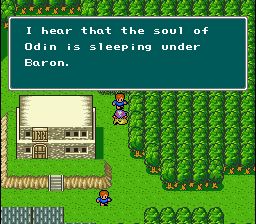 While it’s arguable that the Final Fantasy series is following in the footsteps of Dragon Quest in that Dragon Quest III has a second world map show up near the end as a surprise to the player, multiple full world maps don’t seem to be something the series typically does. You couldn’t even consider the second map to be a full on world map, other than the fact that it really kind of is the world map from the first game. The fourth game in the series features a map of the World of Darkness where you fight Psaro the Manslayer, and the fifth game in the series takes you to a magical pixie land a couple times. It isn’t until Dragon Quest VI and its dream world scenario where the Dragon Quest series finally develops a pair of world maps that you explore at the same time, unlocking things as you go in both worlds; if anything, Dragon Quest may have been following Final Fantasy.
While it’s arguable that the Final Fantasy series is following in the footsteps of Dragon Quest in that Dragon Quest III has a second world map show up near the end as a surprise to the player, multiple full world maps don’t seem to be something the series typically does. You couldn’t even consider the second map to be a full on world map, other than the fact that it really kind of is the world map from the first game. The fourth game in the series features a map of the World of Darkness where you fight Psaro the Manslayer, and the fifth game in the series takes you to a magical pixie land a couple times. It isn’t until Dragon Quest VI and its dream world scenario where the Dragon Quest series finally develops a pair of world maps that you explore at the same time, unlocking things as you go in both worlds; if anything, Dragon Quest may have been following Final Fantasy.
Alas, developing several world maps does take time, money and manpower, and aside from Dragon Quest VII‘s story where a little bit of the world comes back at a time, both Final Fantasy and Dragon Quest would limit the scope of their worlds to one map per game after leaving the SNES era with the very notable exception of Final Fantasy XIV thanks to the Shadowbringers expansion, and possibly Final Fantasy XIII if only on a technicality.
Final Fantasy III was the first game in the series to feature some completely optional dungeons, such that they were. That said, the weapons and extra jobs that were found in the completely optional dungeon Eureka were still required to beat the game unless you wanted to look forward to hours and hours of grinding levels in order to survive the Cloud of Darkness and her very powerful attack. In Final Fantasy IV, there are several optional dungeons that open up once the party finds the Falcon and gets it modified by Cid (so much for his heroic sacrifice) to fly over lava. There’s a side quest to wake Yang up from his coma in the Sylph Cave (so much for his heroic sacrifice, too) by getting a frying pan from his wife and hitting him over the head with it. Rydia can gain a few more summons by taking the party into the land of the summoned monsters.
You could ignore the extra dungeons for now, or you could explore them so that by the time you’re ready to go and get the last crystal, you’ll have powered up Rydia a bunch, and given the rest of your party a few levels more of power. The boss of the Sealed Cave stands no chance against characters who’ve equipped themselves with gear from the optional areas, especially since the gear available in the Sealed Cave is inferior.
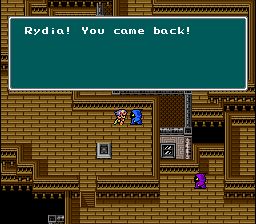 Don’t get me wrong, Leviathan is a handy summon to have and it’s awesome to outgear a dungeon, but this stuff is a lot more optional than the final two jobs in Final Fantasy III were, and you can get away with skipping both of these optional areas, although the reward for hitting Yang with a frying pan is an awesome single use throwing weapon that deals maximum damage to any enemy, even the final boss, so you can start the fight with Zeromus by knocking ten thousand HP off of his total after you use the Crystal on him. (9999 HP, one less than ten thousand.)
Don’t get me wrong, Leviathan is a handy summon to have and it’s awesome to outgear a dungeon, but this stuff is a lot more optional than the final two jobs in Final Fantasy III were, and you can get away with skipping both of these optional areas, although the reward for hitting Yang with a frying pan is an awesome single use throwing weapon that deals maximum damage to any enemy, even the final boss, so you can start the fight with Zeromus by knocking ten thousand HP off of his total after you use the Crystal on him. (9999 HP, one less than ten thousand.)
The one thing that might make some players tear their hair out is the fact that the floor is partially lava in the optional dungeons, and Float wears off every time players move up or down a flight of stairs, so the spell has to be recast all the time when exploring these dungeons.
Aside from optional dungeons, the game also features side quests that range from stuff like the Yang side quest above to things like finding a Pink Tail, the first but certainly not the last side quest in the Final Fantasy series that is all but impossible without a guide, unless you get extremely lucky. The quest involves finding a specific room in which a specific monster appears – and it only appears in one room – in random encounters. The drop rate for the Pink Tail is also super low, so the only way a casual player will ever find it is if they’re super lucky and manage to not only get the enemy to spawn but also manage to please the random number gods enough to get a tail to drop.
To The Moon And Back
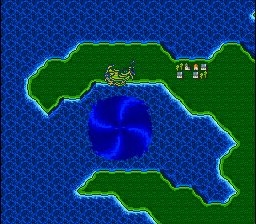 After the second betrayal from Kain, it’s time to go back to Mysidia and find out about an airship called the Lunar Whale. This is the fourth vehicle available to the party, sixth overall if you count the two kinds of chocobos. The Lunar Whale exists to carry players from the earth to the moon and contains beds to rest upon and a Fat Chocobo to store stuff.
After the second betrayal from Kain, it’s time to go back to Mysidia and find out about an airship called the Lunar Whale. This is the fourth vehicle available to the party, sixth overall if you count the two kinds of chocobos. The Lunar Whale exists to carry players from the earth to the moon and contains beds to rest upon and a Fat Chocobo to store stuff.
Something to note about the Fat Chocobo. Those who play the Easytype version will likely never need to use him, even though inventory space is limited. That’s typically because players will likely be selling off older equipment in order to both free up space and gain back some gil so that they can afford all of the upgrades. In this, the game is pretty well balanced. Gil doesn’t have to be accumulated through grinding, but can be acquired naturally. Occasionally, high amounts of gil can be acquired from treasure chests in spots where the developers thought players might be lacking a little. Players will be doing this in all versions, of course, but the Easytype version is lacking many of the items that clog the inventories of other versions of the game, including individual items meant to heal single status effects like Maiden’s Kiss potions to restore a frog’s human form and Echo Herbs meant to cure Silence. Items with effects in battle are also dummied out, like Bacchus’s Cider, which casts Berserk on a party member and Hermes’ Shoes, which has the same effect as Haste.
With all of these items missing from the Easytype version, the Fat Chocobo can easily be ignored, given that most players will likely never run out of space. They’ll come close but never quite fill up their inventory.
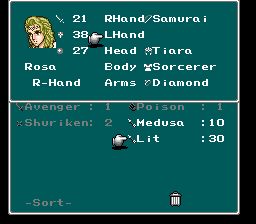
Once on the moon, players can enter Bahamut’s cave in order to try to recruit him as a summon, but for once, even in Easytype, this might be a bit too difficult until players are much stronger. For one thing, one of the enemy encounters in Bahamut’s cave is the Behemoth, a fearsome foe that counters every attack, even magic, with a strong physical blow to a character. The Behemoth has the potential to kill in one hit at this point. It seems like the best thing to do is reflect spells onto him, which is what players have had to do in a couple boss fights already, but Rydia’s spells don’t do enough damage to it yet to justify having to cast Reflect on someone so that she can try to attack without consequence. When Reflect falls off, it can be very devastating to the victim.
This all culminates in a battle with Bahamut which is almost impossible on the party’s first visit to the moon, considering how fast his turns come. The trick is to reflect his Megaflare attack back upon him and defeat him that way, but chances are, the party won’t have enough time to save everyone and will have to maintain with one or two party members for the duration of the battle, which will severely limit damage output and cause several of Bahamut’s Megaflare attacks to happen. If Reflect falls off at any time, that’s game over for the party, and recasting the spell too early will just cause it to be applied to Bahamut instead.
On their return trip to the moon, the party will be much faster and stronger and can reasonably be expected to defeat Bahamut before he can cast Megaflare more than once.
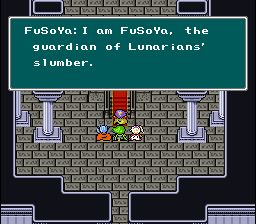 Instead, the party should continue on with the story and head to the castle-looking structure on the moon, which is where an additional eight crystals keep Zemus from escaping. He can still influence Golbez somehow since he’s powerful enough, and Golbez in turn controls Kain in the same way. Within the castle also resides the final character to be introduced, Tellah 2.0. His name is FuSoYa, and his HP is tragically low (although higher than Rydia’s at this point) and his MP refuses to increase unless you go out of your way to grind for levels. Most players will be stuck with him at 190MP, which opens the party up to the same problems that Tellah had, softened somewhat by having a dedicated White Mage and a dedicated Black Mage already in the party, both with a lot more MP to work with. Rydia pretty much already outclasses FuSoYa for damage output and doesn’t need as much babysitting to maintain her MP. Rosa is about on par, if not slightly better at healing than FuSoYa at the point he enters the party. It’s almost like FuSoYa had been meant to be Tellah at one point in development, or the other way around, until he got split off into two different characters.
Instead, the party should continue on with the story and head to the castle-looking structure on the moon, which is where an additional eight crystals keep Zemus from escaping. He can still influence Golbez somehow since he’s powerful enough, and Golbez in turn controls Kain in the same way. Within the castle also resides the final character to be introduced, Tellah 2.0. His name is FuSoYa, and his HP is tragically low (although higher than Rydia’s at this point) and his MP refuses to increase unless you go out of your way to grind for levels. Most players will be stuck with him at 190MP, which opens the party up to the same problems that Tellah had, softened somewhat by having a dedicated White Mage and a dedicated Black Mage already in the party, both with a lot more MP to work with. Rydia pretty much already outclasses FuSoYa for damage output and doesn’t need as much babysitting to maintain her MP. Rosa is about on par, if not slightly better at healing than FuSoYa at the point he enters the party. It’s almost like FuSoYa had been meant to be Tellah at one point in development, or the other way around, until he got split off into two different characters.
This is also how the game fills the fifth party slot while we wait for Kain to return to the side of good once more. If Final Fantasy was influenced by Dungeons and Dragons in how the first and third games handled magic, the fourth game definitely resembles the storytelling method of a months-long Dungeons and Dragons campaign whose participants can’t always make it to the library every Wednesday to participate. This could also be why the characters keep introducing themselves to each other whenever they see someone new. Characters are constantly dropping in and out of the narrative with the exception of Cecil, the only character whom the player has any kind of consistent control over. Either Cecil is a very devoted member of the D&D group or he’s the GM. Him being the GM would go a long way towards helping to explain why the story seems to revolve around him, for what GM would take a chance on centering a plot on one of his players when nearly the entire group has had real life conflict with their plans to get together? Kain’s player clearly just has him turn evil in order to handle his own real life interruptions, Rosa’s player allows her character to get in trouble so that she has a few weeks to deal with whatever’s come up in her life, and so on. Edge’s story comes to an end pretty much right after he gets revenge on Rubicante for what Dr. Lugae did to his parents, likely because his player is new to the campaign and the GM is waiting to see how frequent this newcomer will play.
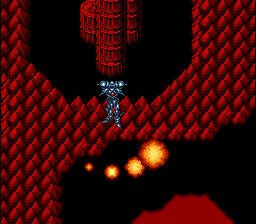 FuSoYa joins the party in order to help deal with the Giant of Babil, which becomes temporarily stunned when the military might of the entire world comes to the party’s aid in their time of need. This trope is one of my favourite, where seemingly everyone the main character has made friends with repays the favour and helps to ease either their physical burden, their emotional burden, or both.
FuSoYa joins the party in order to help deal with the Giant of Babil, which becomes temporarily stunned when the military might of the entire world comes to the party’s aid in their time of need. This trope is one of my favourite, where seemingly everyone the main character has made friends with repays the favour and helps to ease either their physical burden, their emotional burden, or both.
My two favourite examples of this trope, so far, are from two of my favourite games. During the final boss fight of Okami, Amaterasu’s on the ropes and is about to fail her battle with Yami but gets rejuvenated by a bunch of praise that suddenly shows up. It tusns out that Issun, her ally and friend throughout the game, went all over Japan and told everyone about Ammy and what she did for the country and the resulting gratitude strengthened her and helped her to finish the fight. This hit me in the emotions quite a bit because Ammy had barred Issun from following her into the final area, for she was worried about his safety and he didn’t react very well. It was not an amicable split, so it brought tears to my eyes to find out that not only did Issun forgive her for what she did, he made up for his negative reaction by trying to help her in any way he could.
In Final Fantasy XIV: Shadowbringers, the game goes to great lengths to make the player feel the same things their character’s feeling, and does it quite well. At one point, the Warrior of Light is feeling very alone and hopeless in her plight. She’s physically taken on the burden of an entire world and it’s killing her from within. So she resolves to go to the final zone of the game alone to protect her friends from the tragic fate in store for her if she were to fail, and it looks like failure may be the only option for her. As she’s about to leave, her friends confront her and tell her that it’s not her burden alone to bear. As this is happening, everyone she’s ever helped in the Crystarium gathers to support and encourage her and I don’t think I’ve ever cried so much from Final Fantasy ever.
Compared to those, Final Fantasy IV tries. Cid, Edward and even Yang get out of their beds (it’s amazing how many characters made contributions to the plot of the game that left them all bed-ridden) in order to help stop the Giant of Babil in its tracks. All three of these characters are considered dead at one point and all survive in increasingly ridiculous circumstances. At least you know already that they’re alive.
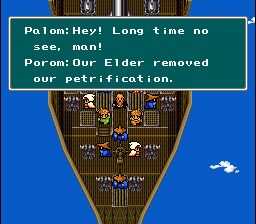 This scene is where Cecil finds out that even Palom and Porom are still alive and have arrived to help with the Giant. Apparently the Elder of Mysidia possesses some kind of Super Esuna which works where regular Esuna does not. Earlier in the game, Rydia comments about how everyone’s so eager to sacrifice themselves and yet not a single one of these so-called sacrifices ever sticks. The only people who stay dead are Tellah and Anna, and Tellah’s death isn’t a sacrifice. He acts out of anger. Anna places herself in front of Edward to shield him from arrows and then once she dies, she stays dead. Her sacrifice is the only sacrifice to actually matter and we hear about her for maybe an hour or so, total, before we see her die. We never actually meet her until she’s already bleeding out and as far as we’re concerned, we have about as much emotional attachment to her as we do to the new ensign wearing red who follows Kirk, Spock and McCoy down to the alien planet to die on literally every episode of Star Trek.
This scene is where Cecil finds out that even Palom and Porom are still alive and have arrived to help with the Giant. Apparently the Elder of Mysidia possesses some kind of Super Esuna which works where regular Esuna does not. Earlier in the game, Rydia comments about how everyone’s so eager to sacrifice themselves and yet not a single one of these so-called sacrifices ever sticks. The only people who stay dead are Tellah and Anna, and Tellah’s death isn’t a sacrifice. He acts out of anger. Anna places herself in front of Edward to shield him from arrows and then once she dies, she stays dead. Her sacrifice is the only sacrifice to actually matter and we hear about her for maybe an hour or so, total, before we see her die. We never actually meet her until she’s already bleeding out and as far as we’re concerned, we have about as much emotional attachment to her as we do to the new ensign wearing red who follows Kirk, Spock and McCoy down to the alien planet to die on literally every episode of Star Trek.
This is why people cry over characters in other Final Fantasy games and shrug over Anna. Tellah’s very upset, but we’re standing there uncomfortably watching the tragedy unfold because we never get to know her. We never meet her, we never travel with her, we never drop in on her when she’s tending flowers in her church.
I wonder if this counts as a spoiler for those who don’t know who else I’m talking about.
Cecil finally finds out about his relationship with Golbez at the end of the Giant of Babil dungeon. What looks like the final confrontation between Golbez and the party is interrupted by FuSoYa breaking the hold Zemus has on him and this is when Golbez’s hold on Kain is broken for good. It’s explained that Golbez was easy to control because of the shared Lunarian blood between him and fellow Lunarian Zemus, and because of the darkness in his heart, but the game doesn’t offer a satisfactory explanation for Kain being mind controlled. Is Kain also Lunarian? Such a thing is never revealed, unfortunately. Instead, we just have to assume it’s darkness in his heart and nothing more. As stated above, I have my own theory, but it would’ve been nice for this plot point to be better explained.
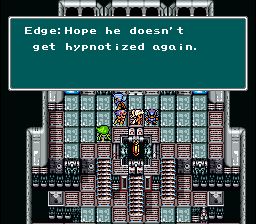 With that, FuSoYa leaves with Golbez and Kain returns to the party, making it the final time the party changes. Kain, Cecil, Rosa, Rydia and Edge go back to the moon to confront Zemus.
With that, FuSoYa leaves with Golbez and Kain returns to the party, making it the final time the party changes. Kain, Cecil, Rosa, Rydia and Edge go back to the moon to confront Zemus.
Actually, Kain, Cecil and Edge go. They attempt to leave Rydia and Rosa behind, thinking they’re protecting the women in their party but the women sneakily stay aboard. I get what Cecil was trying to do, but you don’t tell your best healer (so much better than his own healing magic, light years ahead of Tellah and able to cast a lot more of it than FuSoYa) to stay behind. That’s the quickest path to getting owned by the final boss.
Unlike Final Fantasy III, players don’t need to detour into an optional dungeon to acquire the ultimate weapons and power up for the final boss, all of the weapons are available from boss fights as they descend deep into the moon. One such weapon and a few pieces of armour are hidden almost in plain sight: there’s an invisible path that players might miss, and if they do miss it, they might go into the final boss fight without Cecil’s Crystal Sword, which is so much better than the Excalibur.
If you know what you’re doing and don’t side track too much with things like grinding or flying aimlessly around the world trying to search for where to go next, Final Fantasy IV is actually a relatively short game, especially compared to the previous game in the series. Knowing where to go helps immensely to keep the game’s run time under a full day. A party between level 55 and 60 can defeat the final boss without too much trouble, and players will likely achieve levels like that through the course of normal gameplay. They were the levels I had when I reached the final boss, and I did no grinding, I fought battles as they came and the only “grinding” I did consisted of going to optional areas and grabbing stuff like treasure chests and the optional summons. The time I spent playing this game was approximately twenty two hours and twenty one minutes, although I can’t be sure how exact that was.
Given that this is the first Final Fantasy and potentially the first RPG with an internal clock feature, the clock is a bit glitched. Did you know that if you load up the game and sit on the save screen for a period of time before loading up your save, that time gets added to your clock? I accidentally had the save screen up for about three hours one day since I was busy doing things like cooking food, among other pursuits of mine, and then finally continued playing the game and as soon as I saved, I realized that the game’s clock jumped a lot more than it should’ve. Further tests showed that the clock does indeed count time sitting on the save screen.
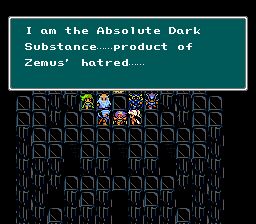 Anyway, right at the very end, Zemus is defeated by FuSoYa and Golbez casting a special combined form of Meteor on him, after which he returns to life a lot more evil than before as Zeromus and defeats them back with a regular Meteor. This leads to another rallying cry from the Earth as literally everyone important who didn’t accompany the party to the final battle begin praying (wishing on the SNES) for the party’s success.
Anyway, right at the very end, Zemus is defeated by FuSoYa and Golbez casting a special combined form of Meteor on him, after which he returns to life a lot more evil than before as Zeromus and defeats them back with a regular Meteor. This leads to another rallying cry from the Earth as literally everyone important who didn’t accompany the party to the final battle begin praying (wishing on the SNES) for the party’s success.
It’s a good thing they do, since Cecil is blasted to one HP by Zeromus’s emergence and the rest of the party are down to zero. Their prayers bring everyone back up to fighting condition (full HP and MP) and then it’s up to Cecil to use a Crystal to make Zeromus vulnerable to damage.
Something players might notice if they hesitate is that the party is sustaining no damage when the battle begins. Zeromus just floats there, kind of vibrating in the air every so often. As far as I can tell, Zeromus neither grows more or less powerful the longer he floats there, so players can prepare for battle before using the Crystal if they’d like. Haste can be applied to everyone, although in versions of the game where many of the items were dummied out, like the Easytype version, only Rosa is able to apply Haste, so this phase of the battle can last longer than it really should. Eventually, when everyone’s ready, Cecil can toss the Crystal and the battle can begin.
There are two ways players can approach the fight. In both ways, the front line party members attack with all they’ve got: Cecil with his sword, Kain with his Jump and Edge throwing Ninja stars until he runs out. The back row’s strategy depends on how daring players want to get. Due to the amount of damage Zeromus can potentially do, some healing is definitely going to be necessary. Although Rydia herself isn’t capable of healing, her optional summon Asura is. The problem with Asura is that if summoned, she’ll randomly cast either a Cure spell or a Life spell. There’s more than one Cure spell she can cast, so theoretically the odds are in your favour if you just want healing, but nothing can suck more than seeing a full party Life spell go off and no one actually needs to get back on their feet, worse if everyone’s on their last legs and a Cure spell is desperately needed.
This offers players an interesting bit of strategy. Holy is very strong against Zeromus, doing close to maximum damage, and Flare does a lot less. Players can be daring and have Rydia summon Asura for healing even though she can potentially be unreliable, leaving Rosa free to blast Zeromus with Holy, or players can play it safe and have Rosa cast Cure 4 on the party and Rydia casts Flare instead. The damage output is lower by playing it safe, but as a result, players won’t be risking their party’s lives.
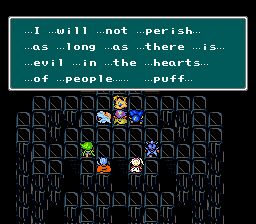 Anyway, once Zeromus dies, he declares that as long as evil exists in our hearts, he’ll always be around. This is the second being of pure evil we’ve fought in a row, with another one coming up in the fifth game. For now, everyone basks in their victory.
Anyway, once Zeromus dies, he declares that as long as evil exists in our hearts, he’ll always be around. This is the second being of pure evil we’ve fought in a row, with another one coming up in the fifth game. For now, everyone basks in their victory.
And so the world rebuilds, new kings and queens ascend the throne, and there’s one thing I have to say about the ending. The dwarves are low on resources for the rebuilding effort so they decide to scrap the tanks and declare that there’ll be no more wars. No! It’s a bad idea! Don’t do it! Or if you do decide to go ahead and render yourselves defenseless, at the very least, plan on figuring out other ways to defend yourselves! There might not be any more wars in the near future, but a couple generations down the line, Cecil and the rest of the party will be gone and there might be other people in power who become tempted towards evil. All you need is one evil emperor and Final Fantasy II will happen all over again.
Universe
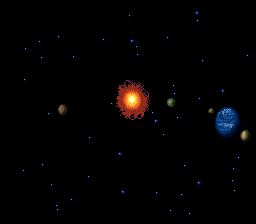 It is suggested that the world of Final Fantasy IV is Earth. Mars and Jupiter are mentioned, as well as the asteroid belt that divides the inner and outer planets of our solar system. At one point, a moving image of the first three planets is shown, with Mercury, Venus and Earth orbiting the Sun. Earth has two moons in this game since one of them is the artificial moon made of an asteroid from the belt, which the Lunarians live on; the belt is basically the remains of their planet. Unlike in Dragon Quest III, the world map doesn’t resemble Earth at all, and none of the place names seem to reflect any real life cultures either. Still, this is the first (and certainly won’t be the last) time the world in a Final Fantasy game is suggested to be Earth. So congratulations, you just saved our world!
It is suggested that the world of Final Fantasy IV is Earth. Mars and Jupiter are mentioned, as well as the asteroid belt that divides the inner and outer planets of our solar system. At one point, a moving image of the first three planets is shown, with Mercury, Venus and Earth orbiting the Sun. Earth has two moons in this game since one of them is the artificial moon made of an asteroid from the belt, which the Lunarians live on; the belt is basically the remains of their planet. Unlike in Dragon Quest III, the world map doesn’t resemble Earth at all, and none of the place names seem to reflect any real life cultures either. Still, this is the first (and certainly won’t be the last) time the world in a Final Fantasy game is suggested to be Earth. So congratulations, you just saved our world!
Final Fantasy IV represents Squaresoft’s growing ambition. As the first game in the series to appear on the SNES, the game looks and feels a lot more advanced than even Final Fantasy III. Many of the improvements that game brought to the series are retained and further improvements are made. Due to time passing during battle, new ways for both players and enemies to fight are possible, and the game’s developers try so many amazing things with the game’s boss fights. Final Fantasy III may look like a golden age Final Fantasy game, but Final Fantasy IV is the first one to feel like a golden age Final Fantasy game.
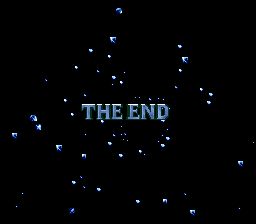
The Final Fantasy and Dragon Quest Retrospective articles will return in 2021!

